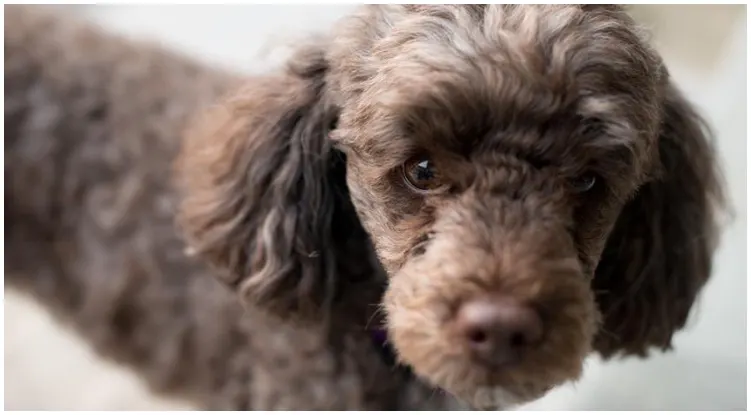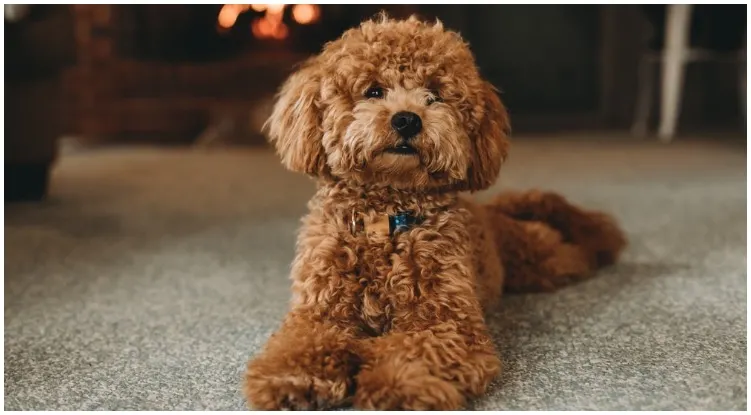Poodles are known as a diverse dog breed. They come in many different color variations and even patterns. But the Brown Poodle might be the cutest one of them, as they basically look like large, living teddy bears. Teddy is actually one of the most popular brown Poodle names.
Teddy Poodles aren’t a separate breed and they basically share all of the characteristics of a regular Poodle. Well, except for maybe being just a little bit more adorable. Take a look at a brown Poodle photo and tell us you don’t feel the same.
Poodles are known for their high intelligence and unbeatable elegance. So if you are considering bringing a Brown Poodle into your home, there are definitely some things that you should think first. Because as smart as they are, they also have another side to them.
Keep on reading to learn more about the Teddy poodle, and see brown Poodle photo.
History and origin
Originally, poodles were retrieving hunting dogs specializing in water hunting. The name comes from an Old German word and means splashing in the water. It is said that he has also served as a herding dog in his history, but this has not been proven. Later the poodle largely lost its hunting skills, but the retrieving joy has remained. He is now valued as a particularly intelligent family dog.
The oldest mention of the poodle from 1555. Back then, two different breeds were called Poodles: the “Beautiful poodle” and sheep poodle. The Poodle breed standard we know today was the “Beautiful Poodle”, and this dog breed is still known for its good looks. But there have been small changes since then.
Back then, the Poodle only came in the three standard colors: white Poodle, black Poodle, and one with a brown coat. Later, a different range of colours was developed as well. As the red poodle, apricot Poodle, cream Poodle, silver Poodle, multicolored Poodles, and many others were also introduced. The first apricot Poodle was classified as a brown one, and the lines in the color variations are still a bit blurry.
How big is the brown color Poodle?
There is a lot of debate about how many sizes of the Poodle there are. Officially, 4 different sizes are recognized currently. This classification is based on their weight and size, specifically their height at the withers. The four sizes are:
- Large poodles (also known as Standard Poodle)
- Medium poodles
- Dwarf poodles
- Toy poodles (also known as Miniature Poodle)
The large Poodle is the breed standard. So when we are talking about the Poodle, more often than not we are talking about this specific size. The size of the breed will also affect their health and activity levels. Look up a brown Poodle photo of every size variation and see which one you like best.
Temperament and Personality
All Poodles, Brown Poodles included, share the same characteristics. They are known for their high intelligence and loving nature. Be warned — they get attached to their owners. Some would even say overly attached. Poodles are in no way low-maintenance dogs. So if you don’t have a lot of free time to give to your dog, this breed isn’t for you.
If Poodles are left alone they can easily fall into destructive behaviors. While most Poodles have good manners and are calm, all of them require training. If you don’t start the training and socialization early, Poodles can turn into stubborn and snappy dogs.
These imposing dogs are very prone to separation anxiety as well, so if you spend a lot of time outside of home, reconsider getting a Poodle. If the anxiety takes them over, they might bark excessively or even pee inside.

What Is A Brown Poodle?
Brown Poodles are just that — Poodles with brown fur. There are many solid color variations of a Poodle’s coat. Such as: white, black, rich reds, brown or even multiple colors like the Parti Poodle. But there are even rare variations such as silver Poodle, blue Poodles
The brown color Poodle is a purebred Poodle, but just in a different color variation. Due to their curly coat and adorable face, these dogs look like real life teddy bears. But the Brown Poodle is still not recognized by the American Kennel Club. Their color can go from a dark brown, chocolate brown to a light brown-cream color.
Just like the most popular black puppies, these dogs also have dark eyes and black noses. They can have a few white spots on their chest or a few white hairs hidden in their coat. Their black points may appear darker in some lightning situations, and it could even look like they have a black coat.
Grooming and General Care
Poodles are not low-maintenance dogs. It does not matter what color their coat is — you can expect to leave a lot of money at the dog salon. But it’s absolutely more than worth it.
Besides regular appointments at the salon, make sure to brush your dog too. That will prevent tangles in their coat.
Additionally don’t forget about the basics as well. Brush their teeth, clean their ears — and also shorten their nails when needed.
Many dog owners wonder do brown Poodles fade, and to be fair, this is possible, especially during the summer months. Sometimes a poodle will be born with a different colored coat than he will and up with, this is also known as ‘clearing’. To clear means that the coat of your dog changes into the color he is supposed to end up with.
Nutrition
Just like with any other dog breed — high-quality dog food and a good diet play a huge role in their overall health. Additionally, make sure that the portions you feed to your dog are appropriate for his size and activity levels.
Most commonly, a standard Poodle will need around 3 to 4 cups of premium dog food per day.
Regularly check your dog’s weight and portion his meals to prevent overeating and obesity. Senior dogs and puppies need special dog food that is costume made for their age needs.
Exercise
Poodles are active dogs and they need good daily exercise to stay happy and healthy. Regular walks coupled with playing or swimming sessions are an excellent way to reduce their energy levels and keep them busy.
Remember, Poodles are intelligent dogs and they can get bored quickly. So make sure you frequently add new toys, and new things to play sessions to make them more interesting.
Health and life expectancy
Poodles are healthy dogs. And a Brown Poodle is no exception. There is no recessive or dominant mutation associated with their coat color that causes specific diseases, like with the silver Poodle. Brown is not a recessive color, while with the silver Poodle it is. This is why the American Kennel Club doesn’t recognize them. However, there are certain diseases that the brown Poodle is prone to.
The most common health issues in Poodles are:
- Epilepsy
- Patellar luxation
- Von Willebrand’s disease
- Hip dysplasia
- Progressive retinal atrophy
- Cushing’s disease
- Addison’s disease
Luckily, all of these conditions are pretty rare and in most cases Poodles will live a long and healthy life. Their life expectancy is about 14 years for a regular size Poodle. Miniature and Toy Poodles usually live longer. A rule of thumb is that the larger the dog breed is the shorter they are expected to live.
The color of a Poodle’s coat does in no way determine his health of the number of years he is expected to live.
How much does the brown Poodle cost?
Now that we know how unique they are, and what wonderful dogs they make, let’s clear out how much do you have to pay extra for brown Poodle puppies. If you are a fan of Poodles you already know that his smart breed is not cheap as it is, however, you will have to pay even more for rare color variations. These include blue Poodles, party Poodles, sliver Poodles. Red isn’t by any means the rarest Poodle color, but the price will still be up there because it is a popular color.
Just like with any other breed, higher demand will make sure that the price is higher as well. The same goes for brown Poodles. Many people are on the lookout for them because they are smart and adorable. So you better prepare yourself that the price will be up there. Depending on the breeder and where you live, be prepared to pay up to $2,000 for a brown Poodle.
Experienced breeders can demand even more money, especially if the parents of your puppy were show ring dogs. Such Poodles should be tested for different hereditary diseases, and the breeder might even start training your pup. The brown miniature Poodle is especially popular, so expect the price of this size variation to be even higher. Other factors that determine the price are your location, the puppy’s months of age,

